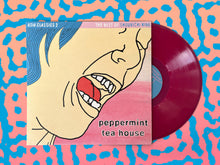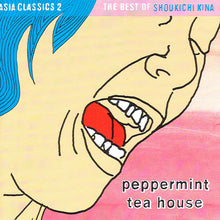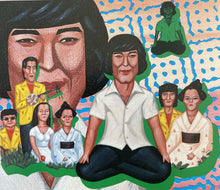"Tears flow when I listen. Kina's music communicates the overflowing spirit and soul of Okinawa." - Ryuichi Sakamoto, 1992
It’s been 30 years since we released this retrospective from the Okinawan icon Shoukichi Kina, and now we're putting it on vinyl (in a limited edition of Pink Peppermint!) for the first time ever.
There’s a lot we could say about the legendary Kina and his influence on popular Japanese music but we’ll let Ry Cooder, who’s featured on most of the songs here, take it away:
“I first met Shoukichi Kina in 1979. David Lindley and I were on tour in Japan, andwere getting well worn out. Kina and a translator met up with us in Osaka and weall sat down in the lobby of this giant tourist hotel, which Kina hated. He just satthere, staring straight ahead, saying nothing for an hour.One year later, a round-trip plane ticket to Hawaii came in the mail, with a note thatread: “ALA MOANA HOTEL, COMMERCIAL RECORDING STUDIO, PLEASE. KINA.”Kina had a habit of throwing himself down onto the floor and kicking his feet whenhe liked a playback. I remember thinking, this beats “one more for us, guys!”
Tracklist:
Shoukichi Kina, who was born in Koza City (now Okinawa City) in 1948, grew up listening to the sound of sanshin played by his father, Shoei, a master of Okinawan music. While in senior high school, Shoukichi Kina composed “Hai Sai Ojisan,” which later became one of the greatest hit tunes ever to originate in Okinawa.
After he entered university in Okinawa in 1966, Shoukichi Kina formed Champloose and, finding it difficult to take his studies seriously, devoted much of his time to music, eventually leaving school entirely. It was around this time that various stories began to emerge — some true, some not quite — of his being a kind of nocturnal “King of Koza,” that he managed the folk music club Mikado, and that he made quite a lot of money as a dealer in a gambling casino.
In any case, perhaps because his first efforts at forming a band were not too successful, it wasn’t until ten years later, in 1976, that he reformed the band around his father’s folk music group. It was from then that the distinctive “Champloose Sound” began to emerge — a unique combination of rock and Okinawan folk that was exactly right for those times, and these times, too.
Before long, the “sound” found avid listeners among musicians and fans on the Japanese main islands, and such was its power that an album was quickly planned and, in 1977, recorded (at the Mikado, as it happened.)
That album, Shoukichi Kina and Champloose, today considered a seminal chapter in the annals of Japanese rock, received overwhelming public attention, particularly as Makoto Yano, Akiko Yano and other famed musical innovators participated in the sessions as guests. Thanks to its nearly instant popularity — and to some adroit timing — the first Champloose concert outside Okinawa, in December 1977, was also a crowning success, with round after round of standing ovations from the sell-out crowd at Tokyo’s Nakano Sun Plaza.
The second Champloose album, Blood Line, released in 1980, was not as quick in coming. But the wait was worth it, for the sessions, recorded in Hawaii with guests including Ry Cooder, Haruomi Hosono, and Makoto Kubota resulted in numbers such as “Jing Jing” (which rose to the Number Two spot on the British disco charts), “Hana…” which was sung by Tomoko Kina, covered by many others and is now a standard in Thailand, and other memorable cuts.
The third and fourth albums, Matsuri, recorded in 1982 in collaboration with Makoto Yano, and Celebration Live, a live album released in 1983, did not disappoint the many fans Champloose had gathered during these busy and fruitful years. Unfortunately, those fans had to wait another seven years for the next album.
Again the wait paid off: in August 1990, a 32-track digital recording machine was “imported” into Okinawa for the sole purpose of capturing the latest Champloose sound — a sound that by then had evolved and expanded to include, in addition to contemporary rock and Okinawan folk, a number of other musical factors ranging from reggae to jazz to Ainu melodies and more. Furthermore, both as a symbol of the wide scope of the group’s musical concepts and as a tribute to the inspiration they had received from Shoukichi Kina’s father, the latter also participated in the recordings.
After the release of that fifth album, fittingly called Nirai Kanai — Paradise, the group returned to active performance, and from May 1991, began work on their sixth and latest album, Earth Spirit.
Five of the 11 numbers on Earth Spirit are traditional Okinawan songs, and while such music normally has no choruses, Kina — joined by his fellow band members and by some outstanding guests from the fertile ethno-pop world of Paris — managed to weave some in, along with (not surprisingly) the irresistible flavors of Africa and the Caribbean as well.






